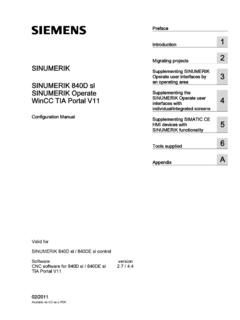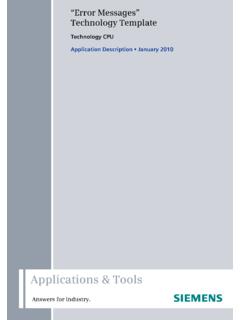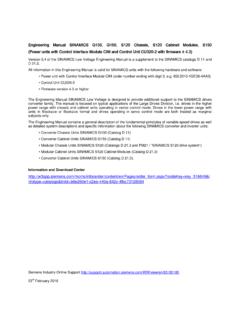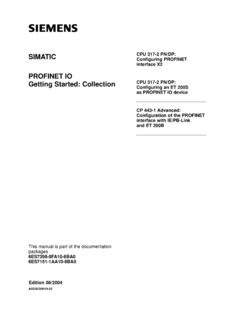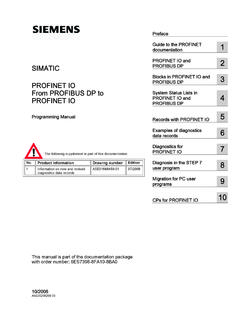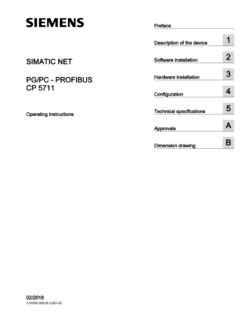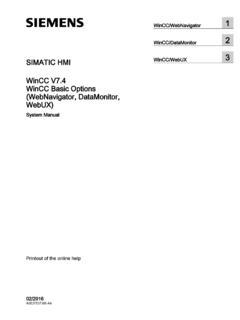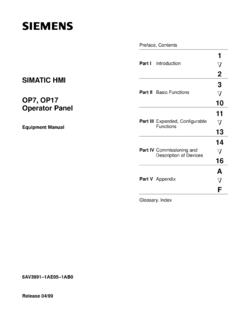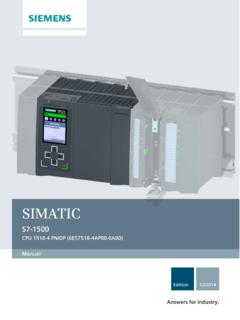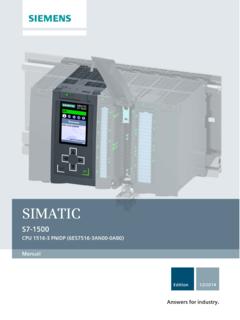Transcription of Manual 5-axis machining - Siemens
1 SINUMERIKM illing with SINUMERIK5- axis machiningManualSINUMERIK5- axis machiningManualValid for:Control systemsSINUMERIK 840 DSINUMERIK 840d slSINUMERIK 840 DiEdition 05/2009 DocOrderNo. 6FC5095-0AB10-0BP1 Basic information1 General information on work-piece production2 Key functions for 5-axis machining3 Aerospace, structural parts4 Driving gear and turbine com-ponents5 Complex free-form surfaces6 Reference section7 IntroductionPrinting history, registered trademarks0 Siemens AG All rights reserved. sinumerik , Manual , 5-axis machining4 sinumerik documentationPrinting history, registered trademarksBrief details of this edition and previous editions are listed status of each edition is shown by the code in the "Remarks" code in the "Remarks" column:A .. New documentationB .. Unrevised reprint with new order numberC.
2 Revised version with new edition statusIf substantive changes have been made on a particular page since the last edition, this is indicated by the new version code in the header on that trademarksSIMATIC, SIMATIC HMI, SIMATIC NET, SIROTEC, sinumerik , SIMODRIVE and SINAMICS are registered trademarks of Siemens AG. Other names in this publication may be trademarks whose use by third parties for their own purposes could violate the rights of the information is available on the Internet at: document was created using a number of layout and graphic reproduction, transmission or use of this document or its contents is not permitted without express written authority. Offenders will be liable for damages. All rights, including rights created by patent grant or registration of a utility or design, are reserved.
3 Siemens AG 1995 - 2009. All rights functions not described in this documentation might be executable in the control. This does not, however, represent an obligation to supply such functions with a new control or when servicing. We have checked that the contents of this document corre-spond to the hardware and software described. However, dif-ferences cannot be ruled out and we can assume no liability for ensuring full consistency. Nevertheless, the information contained in this document is reviewed regularly and any nec-essary changes will be included in subsequent editions. Sug-gestions for improvement are data subject to Introduction Siemens AG All rights reserved. sinumerik , Manual , 5-axis machiningIntroductionContents05 Page1 Basic information .. of 5-axis machining .. axes, rotary axes and kinematics.
4 Quality, accuracy, speed ..142 General information on workpiece production .. chain for producing 5-axis workpieces .. system .. structure for 5-axis machining .. - Measuring in JOG and AUTOMATIC .. up and measuring workpiece in JOG .. tool in JOG .. workpiece in AUTOMATIC .. tool in AUTOMATIC .. the machine with the kinematics measuring cycle CYCLE996 View / Fast display .. - Graphical interface ..383 Key functions for 5-axis machining .. of the terms swivel, frames and TRAORI .. coordinate systems - Frames .. - CYCLE800 .. 5-axis transformation .. speed settings CYCLE832 .. radius compensation with CUT3D .. compensation system (VCS) .. - Virtual machine ..774 Aerospace, structural parts .. functions for structural parts .. example for the pocket on a structural part.
5 815 Driving gear and turbine functions for driving gear and turbine components .. : Turbine blade ..876 Complex free-form surfaces .. functions for free-form surfaces .. : Milling a manta ray ..930 IntroductionContentsIntroductionContents 0 Siemens AG All rights reserved. sinumerik , Manual , 5-axis machining6 Page7 Reference section .. of higher-order functions .. information/documentation .. 110 Basic information of 5-axis axes, rotary axes and quality, accuracy, speed14 Basic Siemens AG All rights reserved. sinumerik , Manual , 5-axis multi- axis machining , the main objectives are to achieve perfect surface quality, precision, and speed without any need for remachining. Within this context, workflow is typically character-ized by the CAD-CAM-CNC process chain. From the CAD system right through to the control system, Siemens can offer an integrated solution for these requirements in the form of its SINU-MERIK controls are equipped with powerful, advanced functions which, when intelligently used, make the whole process of multi- axis programming and machining (particularly 5-axis machining ) considerably easier while at the same time improving the results of Manual is a compact resource aimed at experts working in industrial and research environ-ments who need to get acquainted with the key basic principles of multi- axis machining .
6 Building on this, it also provides machine users with practical tips so that they can organize their work effi-ciently and provides programmers with an insight into the functions of the control and the CAD/CAM regards the various application areas of multi- axis machining , the dedicated functions that have been specifically developed for each area are briefly introduced and considered in many of the aspects cannot be covered in depth by this Manual , you will find additional information in the appropriate sinumerik documentation and relevant literature (See "Further information/documentation" on page 108.)This Manual is designed to supplement the Tool and Mold Making (3 axes) Manual , which deals with the typical functions of 3- axis machining . Please refer to this original Manual for more in-depth information about the basic principles and functions of5- axis machining Siemens AG All rights reserved.
7 sinumerik , Manual , 5-axis machiningBasic of 5-axis machining Free-form surfaces,mold makingDriving gear and tur-bine components, impellersDifferent requirements depending on the application areaStructural parts,aviation industryDesign standards in all application areas are becoming increasingly more in terms of ergonomics, the air drag coefficient (CW value) or simply aesthetic appeal are creating a need for more complex surface geometries to be achieved in less time and with greater precision. The design prima-rily comes from CAD systems, the machining programs from CAM , the skilled machine tool opera-tor still has overall responsibility (in terms of technology) for the quality of the mold and the complete sinumerik , Siemens can provide CNC systems that are perfectly suited to the demands of 5-axis machining as well as HSC applications: Simple to operate User-friendly programming at the machine Optimum performance throughout the CAD - CAM - CNC process chain Maximum control over quality at the machine Optimized 5-axis functionsDepending on the application, the require-ments imposed on the control will vary and a whole range of different functions may be this context, 5-axis machining can be broken down into three broad areas.
8 Free-form surfaces (mold making) Turbine and driving gear components (impellers, blisks) Structural parts (aviation industry) sinumerik can provide optimum support for each of these Siemens AG All rights reserved. sinumerik , Manual , 5-axis axes, rotary axes and Axes and programmingLinear and rotary axesTool tip motionSetting the toolat an angleTo accommodate machining scenarios involv-ing tools set at an angle or in order to mill geometries located anywhere in space, the three linear axes X, Y and Z are required along with two of the rotary axes A, B or C. It must be possible to control the axes tool position is approached in space using linear axes X, Y and Z. This enables the tool tip to adopt any 3- axis machining , you program the three linear axes to achieve the desired machining operations.
9 The contour is milled line by line by moving the three linear the tool also has to be set at an angle, you will need rotary axes as inclination of the tool ( the tool orienta-tion) is changed using two axes of rotation, B and is necessary, for example, if the tool needs to be angled in relation to the machin-ing surface or if you want to mill a pocket with inclined walls within the context of circumfer-ential three linear axes and two rotary axes, theoretically any point in space can be approached with any tool orientation. This is the basis of 5-axis machining . Siemens AG All rights reserved. sinumerik , Manual , 5-axis machiningBasic programming optionsDirection vectorprogrammingRotary axisprogrammingIn addition to programming based on the direction vector and rotary axis positions, other forms of angle programming are also common.
10 These include, for example, Euler or RPY angles. Further information regarding this can be found in Section Tool orientation on page the purpose of 5-axis machining , the ori-entation of the tool needs to be defined in addition to the position setpoint of the machin-ing point. The position setpoint is defined in the CNC program by means of the coordinate axes X, Y, and describing the tool orientation, it makes sense to specify the direction vector A3, B3, and C3 so that the orientation can be pro-grammed independently of the machine enables the position setpoint and tool ori-entation to be defined in a unique example shows the tool in the position (0,0,0) as a diagonal of a cube ( in rela-tion to X-Y plane).N100 G1 X0 Y0 Z0 A3=1 B3=1 C3=1C3B3A3 The same position can be achieved as with tool orientation by specifying it on the basis of the rotary axis position in the above example would be expressed as follows:N100 G1 X0 Y0 Z0 B= C=45 The example shows the tool in the position (0,0,0) as a diagonal of a cube ( in relation to X-Y plane).
